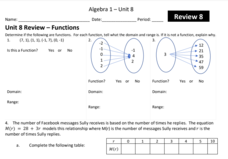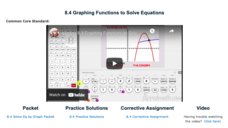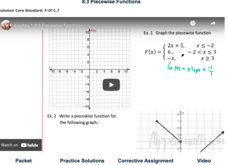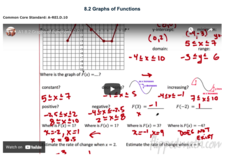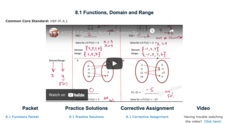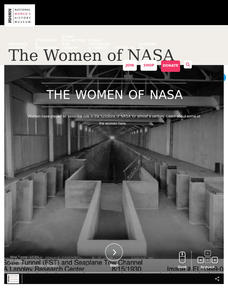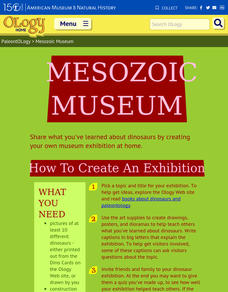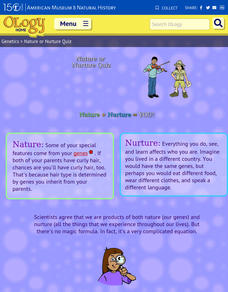Flipped Math
Greatest Common Factor
Break it down to solve it. Learners watch a video on how to factor out the greatest common factor for algebraic expressions. They see how to use factoring and the zero product property to solve polynomial equation and practice their...
Flipped Math
Unit 8 Review: Functions
Let's finish a functional review. Pupils work through 31 items to review the concepts learned in Unit 8. Scholars determine whether a mapping is a function and identify the domain and range. Using function notation, individuals then...
Flipped Math
Graphing Functions to Solve Equations
Intersections become solutions. Scholars watch a video on using a graphing calculator to find the solution to an equation in one variable. While watching the presentation, pupils practice working some of the examples and compare their...
Flipped Math
Piecewise Functions
Break it up into pieces to solve the problem. Individuals watch a video on how to graph and determine the equation and values of piecewise functions. Viewers then work several exercises to practice evaluating a piecewise function at...
Flipped Math
Graphs of Functions
Create a graphical description. Pupils watch a video presentation starting with vocabulary on properties of a graph of a function and then use the vocabulary to find key features of graphs of a function. Scholars use three graphs in the...
Flipped Math
Functions, Domain and Range
Take a deeper dive into the notation of a function. The video presentation uses grocery store prices as an example to explain the concept of a function. Pupils determine whether mappings are functions or not and find the domain and...
Flipped Math
Linear vs. Exponential
Linear or exponential?. Learners watch an informative video comparing situations that may be modeled by either a linear or exponential relationship. Pupils determine the type of relationship and then create a function that models the...
Flipped Math
Exponential Decay
The values keep getting smaller—quickly! Pupils watch a video that contrasts exponential decay with exponential growth from the first lesson in the unit. Learners identify exponential functions that are decaying and create graphs of...
Flipped Math
Exponential Growth
They grow by leaps and bounds. Learners watch a quick review on function notation as they prepare to learn more about exponential growth. Using their knowledge from sequences, pupils find out whether a function is linear or exponential,...
Flipped Math
Recursive Formulas
Write formulas that depend upon previous terms. Individuals watch a video that explains how to create a recursive formula based on a sequence of numbers. Learners find out how to determine whether a sequence is geometric or arithmetic...
Flipped Math
Sequences
Develop a sequence of descriptions. Learners watch an introduction to sequences, their notations, and how to graph them. Pupils use full sentences to describe the sequence and how to get from one term to the next, without needing to...
Flipped Math
Correlation
Determine how close the line is to the scatter plot. Clear video instruction shows how to plot a scatter plot and find the best fit line using the linear regression function on a calculator. Pupils use the information from the calculator...
Exploratorium
A Splash of Color - Is Pure Water Colorless?
What makes the ocean blue but a glass of ocean water nearly colorless? Investigators prepare tubes of water to examine the color of water. Scholars discover the relationship between light absorption, color variations, and water depth as...
Exploratorium
Skin Shield - Explore the Body’s First Line of Defense Against Pathogens
Make pathogens and the body's defense systems come alive for young biologists in a hands-on activity. Investigators model the skin's protection against infection by observing and comparing changes in a punctured tomato and an intact...
American Museum of Natural History
Space Jell-O
A tasty treat lends its curious substance to space exploration. Mimicking the discoveries of Albert Einstein, young astronomers beginning by making a batch of Jello-O, then four hours later, scholars place edible objects that act like...
Flipped Math
Explicit Formulas
Find a faster way to determine the 100th term of a sequence. Learners watch a video providing instruction on a way to find the nth term of a sequence—without writing down all the previous terms. Scholars create explicit formulas for...
Flipped Math
Unit 5 Review: Bivariate Data
The data says it's a wrap. Pupils work through four review questions with multiple parts dealing with bivariate data. Questions cover creating and interpreting two-way tables and scatter plots with lines of best fit. Scholars finish up...
Flipped Math
Frequency Tables
What's the association? Pupils watch a presentation on creating a two-way frequency table. Learners find out how to calculate relative frequencies within the table to determine whether there is an association between the two categories....
National Woman's History Museum
The Women of NASA
Human computers? Although it may sound like science fiction, the term was used to describe the women who made the NASA calculations before the advent of electronic computers. A 21-slide presentation introduces viewers to the women who...
American Museum of Natural History
Mesozoic Museum
Mini museum curators create an exhibit that showcases the Mesozoic era. Pupils use their knowledge of dinosaurs to make informative posters, drawings, and dioramas. Following three steps to complete the hands-on activity, scholars read...
American Museum of Natural History
The Pre-History Proudly Presents: Face-To-Fossil
An engaging interview allows scholars to get to know Proto Andy, a protoceratops fossil. Following along with the transcript, learners delve into six questions, including how he became a fossil, what he was like when he was alive, and...
Flipped Math
Calculus AB/BC - Defining Continuity at a Point
Learning about continuity is a continuous process. An educational video first shows individuals the definition of continuity at a point. They see several examples on the topic and then investigate how to identify the types of...
Flipped Math
Calculus AB/BC - Exploring Types of Discontinuities
Continue one's studies by studying discontinuities. The 11th of 18 lessons in Unit 1 - Limits and Continuity first describes the different types of discontinuities. By watching a video, pupils learn to algebraically determine the...
American Museum of Natural History
Nature or Nurture Quiz
Eighteen questions ask pupils whether certain behavior or trait is based on nature or nurture. Scholars take a quiz, reflect on their answers, then challenge a friend or family member to complete it.



